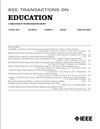在线课程中的视频可视化概况分析
IF 2.1
2区 工程技术
Q2 EDUCATION, SCIENTIFIC DISCIPLINES
引用次数: 0
摘要
本文分析了学生的视频可视化特征,目的有两个:1) 识别视频中的难点部分;2) 根据视频可视化特征预测学生成绩。为识别视频中的关键部分,提出了两个新颖的指标。第一个指标旨在衡量所描述概念的复杂性。第二个建议是识别视觉上更复杂的视频部分。对于第一个指标,使用的是前向和后向传递的平均次数。一个区域的后向(前向)通过次数越多,说明该部分越具有挑战性(越容易)。为了识别具有复杂视觉效果的部分,记录了停顿的次数。最后,通过检测视频与相关问题之间的一致性来预测学生的成绩。结果表明,视频可视化配置文件是识别视频和问题一致性的良好工具。本文章由计算机程序翻译,如有差异,请以英文原文为准。
Video Visualization Profile Analysis in Online Courses
In this article, student video visualization profiles are analyzed with two objectives: 1) to identify difficult sections in videos and 2) to predict student performance based on their video visualization profiles. For identifying critical sections in videos two novel indicators are proposed. The first one is designed to measure the complexity of the concept being described. The second proposal, identifies video sections that are more visually complex. For the first indicator, the average number of forward and backward passes are used. The higher the number of backward (forward) passes over a region, the more challenging (easy) the section is. For identifying sections with complex visuals, the number of pauses is recorded. Finally, the student performance prediction is carried out with the purpose of detecting the alignment between videos and their related questions. The results show that video visualization profiles are a good tool to identify video and question alignment.
求助全文
通过发布文献求助,成功后即可免费获取论文全文。
去求助
来源期刊

IEEE Transactions on Education
工程技术-工程:电子与电气
CiteScore
5.80
自引率
7.70%
发文量
90
审稿时长
1 months
期刊介绍:
The IEEE Transactions on Education (ToE) publishes significant and original scholarly contributions to education in electrical and electronics engineering, computer engineering, computer science, and other fields within the scope of interest of IEEE. Contributions must address discovery, integration, and/or application of knowledge in education in these fields. Articles must support contributions and assertions with compelling evidence and provide explicit, transparent descriptions of the processes through which the evidence is collected, analyzed, and interpreted. While characteristics of compelling evidence cannot be described to address every conceivable situation, generally assessment of the work being reported must go beyond student self-report and attitudinal data.
 求助内容:
求助内容: 应助结果提醒方式:
应助结果提醒方式:


